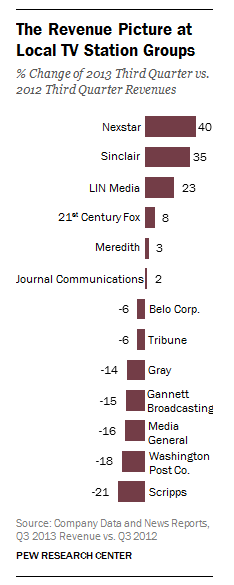
Media companies’ rush to acquire local television stations produced largely positive results in the third quarter, but some companies suffered losses tied to a plunge in advertising dollars.
Revenue from six of the 13 major station-owning groups, all of them public companies, increased in the third quarter of 2013 compared with the same period a year earlier.
The leaders were Nexstar, at 40% growth, and Sinclair, at 35%. Nexstar owns 75 television stations, which reach 44 markets across the country, and Sinclair operates 163 television stations in 77 markets.
Seven companies showed revenue declines year-to-year, with Scripps (-21%) and Washington Post Co. (-18%) suffering the biggest losses. (Following the sale of the flagship paper, The Washington Post Co. is being renamed the Graham Holdings Co.) Scripps owns 19 local TV stations in 13 markets and The Washington Post Co. owns six stations in major cities in Florida, Texas and Michigan.
Some of the big winners can chalk up their revenue growth to the wave of station consolidations that has occurred this year. One significant reason behind Nexstar’s revenue growth is its acquisition of Citadel Communications’ five stations in September, after buying 19 stations from Communications Corp. of America, in April. Sinclair’s increase was also partly due to its purchase of seven stations from Allbritton Communications in July and 22 Fisher Communications stations in August.
There are some cases however, where station acquisitions did not help local TV station companies post gains. Even though Tribune Co. purchased 19 local TV stations in July, it still lost 6% of its revenues. The company attributed that decline in part to the “significantly lower ratings” for baseball on WGN-TV and WGN-AM 720—broadcast home of the last place Chicago Cubs.
The story from Scripps, which reported the steepest year-to-year decline in revenues in the third quarter, illustrates what can happen to television stations in non-election years. In 2012, a record $3.1 billion was spent for political ads on local television. In the third quarter of 2012, Scripps stations brought in almost $33 million from political ads. In the same quarter in 2013, that revenue stream accounted for only $1 million.
The Washington Post Co. reported a revenue decline of 18%, which included the loss of almost $16 million in political advertising dollars. The company also reported another loss of $11 million in revenue, in part because there were no Olympic games to generate the advertising dollars that flowed to its NBC affiliates from that event in 2012.
One of the positive developments for local television stations, which has helped compensate for political advertising losses, is the significant increase in revenues from retransmission fees. These fees, which are paid by cable and satellite operators to carry local broadcast channels, have been growing rapidly in recent years. For example, in its first three months as a separate company, 21st Century Fox—which was created after the split of News Corp. into separate publishing and entertainment/broadcast units—reported an 8% revenue increase on an adjusted basis. That growth was fueled by doubling the retransmission consent revenue. Nexstar also reported a 69% increase in its retransmission fee revenues, which now comprise about 20% of its total revenues.
